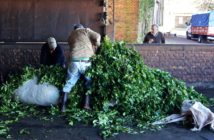When a British settler named G.W.L. Caine brought the first tea plants to Kenya in 1903, he did so simply because they were beautiful. Following the newly-built railway into the East African interior, Caine imported Indian tea bushes as ornamentals, planting a handful of the emerald-leafed shrubs on the forested hills of Limuru.
Today Caine’s bushes, over a century old, have grown into trees in a tea garden now called Mabroukie. Just north of author Isak Dinesen’s beloved Ngong Hills, Mabroukie spreads its leafy carpet over a gently rolling landscape punctuated by small farms and homesteads. It stands as a reminder of an idea that would forever change the face of Kenya, and the history of tea.
Caine may not have realized it at the time, but equatorial Kenya is one of the most ideal places on Earth to grow tea. Its high elevations, even rainfall and loamy, volcanic soil makes the bushes flourish, and the mild climate means the leaves can be harvested year-round. Colonial settlers, frustrated to find that their plots were located at elevations too high for coffee, started turning to tea in the 1920s. The British colonial administration soon realized it could be a lucrative cash crop.


